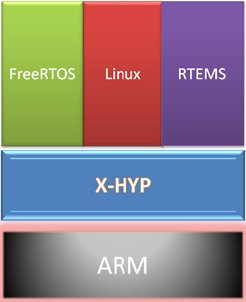 We port Xhyp on your hardware, we port your
OS or application on Xhyp
read more
We port Xhyp on your hardware, we port your
OS or application on Xhyp
read more
Howto: Running X-hyp binaries demo.
...read more
Howto: Run your own RTOS in X-hyp.
...read more
Howto use the X-hyp configurator.
...read more
FAQ: Frequently Asked Questions on Licensing.
...read more
Howto use the X-Hyp framework to port an RTOS to X-Hyp.
...read more
Source code example: a hello world domain for X-Hyp.
...read more
Binary testing: using X-Hyp ARINC like scheduling.
...read more
IST Project: OCERA, Open components for realtime applications.
...read more
X-HYP Documentation
Hypercalls description, howto and wiki
The Xhyp documentation
- Documentation on binaries demos
- Documentation on library demos
- Documentation on X-Hyp configurator
- Documentation on X-Hyp licensing
- X-Hyp Framework description
- X-Hyp ABI: using X-hyp hypercalls
- X-Hyp API: using X-hyp library interface
Using the binaries demos
X-hyp proposes two free demos you can use within QEMU. If you do not know QEMU visit the site at http://www.qemu/.org, QEMU is an emulator created by Fabrice Bellard and which code is used by most of the free hypervisors like virtualbox, xen or kvm.
X-hyp do not use QEMU code but the demos use it as an emulator to allow you to run X-Hyp without having appropriate hardware. Of course you can not make any latency measure inside of the QEMU emulator.
Follow the link to the binary demos to learn how to download and use the pre compiled free demos with POSIX or ARINC scheduler inside of QEMU.
X-Hyp Libraries demo
If you want to get more involved with X-Hyp you may want to use our Library Demo with this demo you will be able to:
- Configure X-hyp domains, and add pre-built partitions like one or more FreeRTOS or standalone demos and one console driver partition. Doing this you should use our easy to use Xhyp configuration tool.
- Built your own domain, using our standalone demos as a skeleton you may developp your own domain and schedule it along with a console driver partition and one or more FreeRTOS.
- Built your own FreeRTOS application, using the FreeRTOS application example, you may want to enhance it and developp you own application running inside of Xhyp.
X-Hyp free includes an application builder
X-Hyp free application builders allows you inside a semi-graphic dialog menu to:
- Choose partitions sizes
- Incorporate your para virtualised guest with X-Hyp
- Choose the scheduling scheme you want to use, POSIX, ARINC or Sporadic
- Define the priorities associated to each partition for POSIX scheme
- Define ARINC major and minor frames and periods
Dual licensing
X-HYP is available under two different license:
- A GPL-v2 license available for Universities and testing purpose
- Commercial license for product embedding
X-hyp framework
Before developping your own domain and letting it scheduled by X-Hyp you will want to know more about X-Hyp framework, and things like:
- X-Hyp memory usage and constraints.
- How do I use interrupts inside a domain
- How do I register a page fault handler
- How to use system calls inside of a domain
- How to developp a driver
Using X-hyp Hypercalls
If you want to port your own operating system to X-hyp you will need to use the X-hyp hypercalls to handle all access to hardware, CPU configuratio, MMU or MPU configuration and Cache configuration. To do this you may want to use the X-Hyp C Library interface or if you use another programming language the assembler hypercall interface.
Follow the following link to the documentation on assembler hypercall interface.
Using X-hyp Library interface
If you use C programming language to port your own operating system to X-hyp you can use the "X-hyp Library interface" to handle all access to hardware, CPU configuratio, MMU or MPU configuration and Cache configuration.
Follow the following link to the documentation on C library interface.
Howto use the X-Hyp framework to port an RTOS to X-Hyp.
...read more
Howto use the X-Hyp Assemblor Hypercall API.
...read more

Binary testing: using X-Hyp ARINC like scheduling.
...read more
Howto: Running X-hyp binaries demo.
...read more
Howto: Run your own RTOS in X-hyp.
...read more
Howto use the X-Hyp C hypercall API.
...read more
IST Project: OCERA, Open components for realtime applications.
...read more
Source code example: a hello world domain for X-Hyp.
...read more
Designed and built by M.N.I.S.
Using Bootstrap licensed under Apache V2 and Glyphicons Free licensed under CC BY 3.0.
